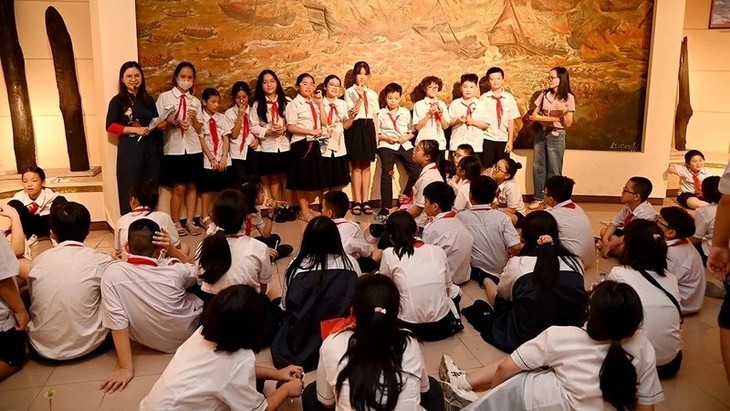With a role of providing spaces for comprehensive educational experiences, museums in Ha Noi have innovated their methods to bring cultural products closer to the public. Various educational and interactive programs are integrated with exhibitions and seminars, both to attract visitors and to encourage learning, exploration, and creativity.

Students learn history at the Vietnam National Museum of History. (Photo: Thu Minh/nhandan.vn)
Ha Noi is home to approximately 20 museums along with numerous galleries, which are categorized into two main themes: history-military, and culture-arts and social issues, connecting cultural heritages and art with modern life.
Located on Trang Tien street, the Vietnam National Museum of History is a distinctive architectural landmark in the capital city. It preserves over 200,000 artifacts and documents related to Vietnam's cultural and historical heritages, together with national treasures and relics. 60-70% of visitors are young people.
Education is the key activity at the Vietnam National Museum of History. The museum has developed a number of programs tailored for different visitor groups, including educational activities for families, where parents and children participate together in interactive experiences, extracurricular activities for schools, and specialized educational programs, such as workshops and exchanges targeted specific groups.
Dr. Lu Thi Thanh Le, head of the Interdisciplinary Studies and Arts Department at Vietnam National University, said that museums are places that attract various units and organizations to collaborate and develop community education programs.
“There are programs led directly by the museum as well as programs implemented in collaboration with other entities. In addition, there are socialized programs brought into the museum by organizations to enrich educational experiences,” she said.
Meanwhile, the Ha Noi Museum mainly focuses on family experiences. With the advantage of preserving a treasure trove of over 73,000 documents and artifacts on the history of the capital, along with a spacious campus, the museum organizes many engaging educational activities linked to intangible cultural heritages, making it a popular destination for families.
“This is the first time my children have seen such artifacts. They are gaining more complete and profound knowledge," Ha Noi resident Phuong Thanh said.

Hoang Yen Trang, a student from Tay Ho District, shows her silk art work after attending a workshop at the Ha Noi Museum. (Photo: Le Chi/VOV5)
The Ha Noi museum enables visitors to gain a deeper understanding of the nation’s culture and traditional crafts. They can take part in activities such as trying on traditional Vietnamese costumes, practicing Vietnamese calligraphy, learning to make toy figurines called to he, making Chuong village conical hats, Me Tri green rice, and Bat Trang pottery products, and enjoying Dao Thuc water puppetry and ca tru ceremonial singing.
"Youth, pupils, and students in Ha Noi and other northern provinces and cities are the target audience for our educational work. With the advantage of having original artifacts, we provide them with direct education based on museum exhibits,” said Dang Minh Ve, Deputy Director of the Ha Noi Museum.
During a visit to the Co Loa Relic Site, students from Co Loa Secondary School had the opportunity to learn about the history of the Co Loa Citadel.
"After learning about the Co Loa Citadel, I discovered that it was constructed with three concentric earthen walls, creating a military base for infantry and naval forces," student Pham Hoang Anh said.
Nguyen Thi Thuy, Head of the Heritage Department of the Co Loa Relic Site Management Board, said that after two years of researching the history of the Co Loa Relic Site and its legend of the magical crossbow, they have developed an experience zone here.
“The program brings joy to students and gives them a greater love for their heritage,” said Thuy.
Museums serve educational purposes and provide meaningful experiences for visitors. The educational activities at museums bring Vietnam's cultural heritage closer to the public and make the museums interesting and beneficial destinations.